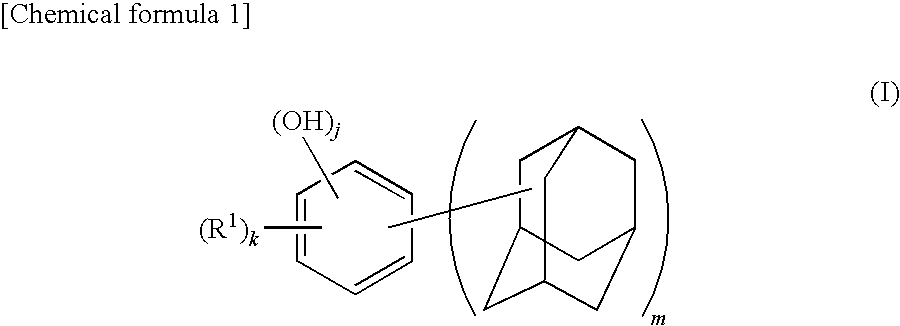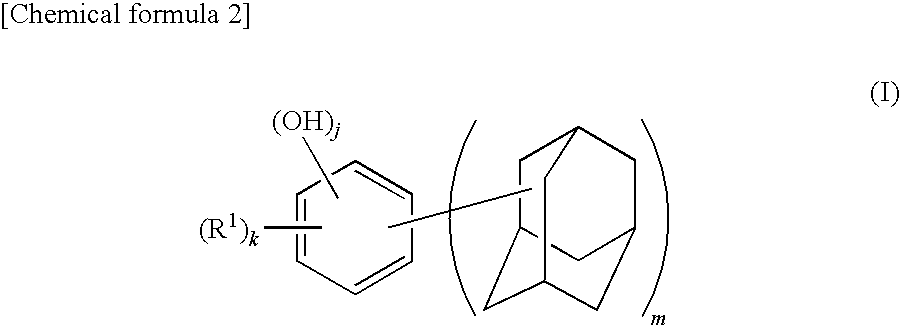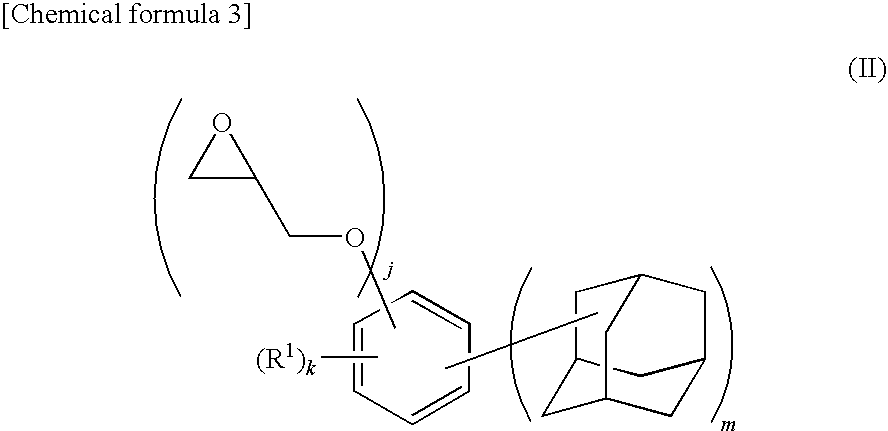Adamantane derivative, method for producing the same, and resin composition containing adamantane derivative
- Summary
- Abstract
- Description
- Claims
- Application Information
AI Technical Summary
Benefits of technology
Problems solved by technology
Method used
Image
Examples
example 1
Synthesis of 4,6-bis(1-adamantyl)-1,3-dihydroxybenzene
[0124]A 500 mL four-necked flask equipped with a reflux condenser, a stirrer, a thermometer, and a nitrogen inlet tube was charged with 28.1 g (0.18 mol) of 1-adamantanol, 15.84 g (0.09 mol) of p-toluenesulfonic acid monohydrate, and 300 mL of heptane and replaced with nitrogen. The mixture was added with 9.9 g (0.09 mol) of resorcinol. The flask was immersed in an oil bath at 100° C. and the mixture was heated while stirring for 1 hour. After cooling the reaction mixture, the solid content was collected by filtration, which was then dried under vacuum, followed by recrystallization by aqueous methanol solution to obtain 4,6-bis(1-adamantyl)-1,3-dihydroxybenzene (yield: 86%, LC (liquid chromatography) purity: 99.7%, melting point: 146° C.). Note that the LC purity was measured by absorbance at λ=280 nm.
[0125]The obtained 4,6-bis(1-adamantyl)-1,3-dihydroxybenzene, was identified by nuclear magnetic resonance spectrum (1H—NMR and 1...
example 2
Synthesis of 4,6-bis(1-adamantyl)-1,3-digylcidyloxybenzene
[0128]A 500 mL four-necked flask equipped with a reflux condenser, a stirrer, a thermometer, and a nitrogen inlet tube was charged with 57 mL of MIBK, 157 mL of DMSO, and 98 g (1.057 mol) of epichlorohydrin and replaced with nitrogen for 30 minutes. To this solution, 52.01 g (0.137 mol) of 4,6-bis(1-adamantyl)-1,3-dihydroxybenzene synthesized in Example 1 was added, and the flask was replaced with nitrogen for 30 minutes and then heated at 45° C. while stirring. This solution was added with 11.6 g (0.290 mol) of sodium hydroxide over 0.5 hour and the solution was stirred for 1.5 hours. Then, 2.9 g (0.0725 mol) of sodium hydroxide was added and the solution was further stirred for 1 hour. The reaction mixture was cooled to room temperature, and 300 mL of chloroform was added. After washing with 500 mL of water, an aqueous 0.1 mol / L HCl solution was added to the mixture and the organic layer was separated. After further washing...
example 3
[0132]5 g of 4,6-bis(1-adamantyl)-1,3-diglycidyloxybenzene obtained in Example 2, 3.06 g of methylhexahydrophthalic anhydride (MH700 manufactured by New Japan Chemical Co., Ltd.) as an acid anhydride, and 0.1 g of octylic acid salt of 1,8-diazabicyclo[5.4.0]undecene-7 (SA102 manufactured by San-Apro Ltd.) as a curing accelerator were mixed at room temperature and, after defoaming, the mixture was heated at 110° C. for 2 hours and then at 170° C. for 4 hours to produce the cured resin (a sheet of 3 mm thickness). The glass transition temperature and light transmittance of the obtained cured resin product were measured, and further the light resistance test and long term heat resistance test were carried out. The evaluation results are shown in Table 1.
PUM
 Login to View More
Login to View More Abstract
Description
Claims
Application Information
 Login to View More
Login to View More - R&D
- Intellectual Property
- Life Sciences
- Materials
- Tech Scout
- Unparalleled Data Quality
- Higher Quality Content
- 60% Fewer Hallucinations
Browse by: Latest US Patents, China's latest patents, Technical Efficacy Thesaurus, Application Domain, Technology Topic, Popular Technical Reports.
© 2025 PatSnap. All rights reserved.Legal|Privacy policy|Modern Slavery Act Transparency Statement|Sitemap|About US| Contact US: help@patsnap.com



